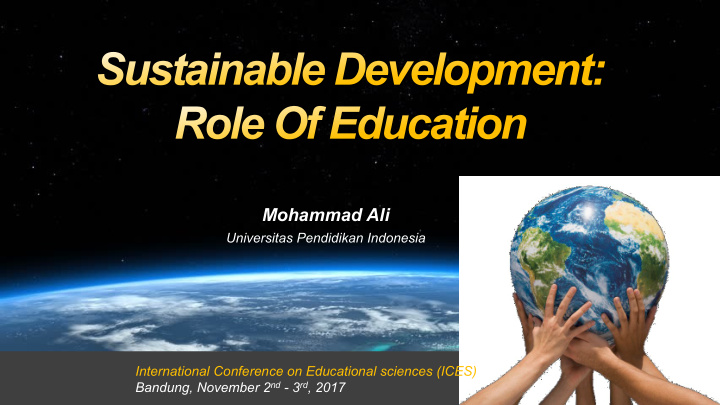



Mohammad Ali Universitas Pendidikan Indonesia International Conference on Educational sciences (ICES) Bandung, November 2 nd - 3 rd , 2017
WHAT IS SD ? Sustainable development: A concept of development in fulfilling the needs and improving the welfare of the people in present time, while taking into account the needs of future generation.
Sustainability - initially a concept to conserve & improve environment June 1972 - UN Conference on Human NATURE Environment (UNCHE), in Stockholm, Sweden - 114 countries participated Conclussions - Poverty and lower education level are the key factors causing the environment damage
It’s agreed to connect policies of development to environment conservation. Environment problem needs strategic & long-term solution. It needs collective agenda of the global community. The conference Promoted UNESCO to implementation the 4 agenda.
in the Brundtland 1987 Report – itwas applied in Sustainability economic, applied in the ecological, and 1980s context of world’s social aspects natural and biosphere protection
ESD includes aspects Socio-cultural 2 1 Environment 3 Economic
• 199 992 , UN Conference on Environment and Development (UNCED) in Rio de Janeiro, Brazil. • 170 countries signed the Agenda 21-> SD as a global objective, global cooperation and partnership to deal with world’s ecological and social problems.
200 2005 2001 UNESCO’s proclamation of DESD 205 -2014 Development should take into 2001 account the principles of sustainability to fulfill the present generation’s needs without risking July 2001, EU conference the fulfillment of the future (Gothenburg, Sweden) generation’s needs on the future of Europe
Cultivating Education plays UNESCO is awareness, an important responsible knowledge, skill, role in the for its the attitude toward implementation GAP on ESD SD are through of SD education.
This requires us to reorient education systems, policies and practices in order to empower everyone, young and old, to make decisions and act in culturally appropriate and locally relevant ways to address the problems that threaten our common future (UNESCO,2014). ESD by Prof. Dr. Mohammad Ali, MA _Indonesia University of Education
ESD -> Processes which emphasize on the need for stimulating a holistic, integrated and interdisciplinary approach to developing the knowledge and skills needed for a sustainable future as well as changes in values, behaviour, and lifestyles.
ESD is a new vision of education A vision that helps people of all ages better understand the world in which they live, addressing the complexity and interconnected-ness of problems such as poverty, wasteful consumption, environmental degradation, urban decay, population growth, health, conflict and the violation of human rights that threaten our future (Unesco, 2014)
ESD is about learning to: Respect value & preserve achievements of the past; Appreciate the wonders and peoples of the earth; Live in a world where all people have sufficient food for a healthy and productive life;
International Agenda
Global Action Program (GAP) on ESD To mobilize education and learning in regard to accelerating progress towards sustainable development. Reorienting education and Enhancing the role of learning so that everyone has education and learning in all the opportunity to acquire the relevant agendas, values, skills and knowledge that programmes and activities empower them to contribute to that promote sustainable sustainable development. development.
ESD aims at • Improving access to quality basic education, • Reorienting existing education, • Improving public understanding and awareness, and • Providing training
The implementation of ESD features: 1. Interdisciplinary and holistic 2. Values-driven 3. Multi-method 4. Participatory decision-making 5. Applicability 6. Locally relevant (Unesco, 2014)
THAK YOU 18
Recommend
More recommend